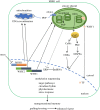Organellar protein multi-functionality and phenotypic plasticity in plants
- PMID: 31787051
- PMCID: PMC6939364
- DOI: 10.1098/rstb.2019.0182
Organellar protein multi-functionality and phenotypic plasticity in plants
Abstract
With the increasing impact of climate instability on agricultural and ecological systems has come a heightened sense of urgency to understand plant adaptation mechanisms in more detail. Plant species have a remarkable ability to disperse their progeny to a wide range of environments, demonstrating extraordinary resiliency mechanisms that incorporate epigenetics and transgenerational stability. Surprisingly, some of the underlying versatility of plants to adapt to abiotic and biotic stress emerges from the neofunctionalization of organelles and organellar proteins. We describe evidence of possible plastid specialization and multi-functional organellar protein features that serve to enhance plant phenotypic plasticity. These features appear to rely on, for example, spatio-temporal regulation of plastid composition, and unusual interorganellar protein targeting and retrograde signalling features that facilitate multi-functionalization. Although we report in detail on three such specializations, involving MSH1, WHIRLY1 and CUE1 proteins in Arabidopsis, there is ample reason to believe that these represent only a fraction of what is yet to be discovered as we begin to elaborate cross-species diversity. Recent observations suggest that plant proteins previously defined in one context may soon be rediscovered in new roles and that much more detailed investigation of proteins that show subcellular multi-targeting may be warranted. This article is part of the theme issue 'Linking the mitochondrial genotype to phenotype: a complex endeavour'.
Keywords: WHIRLY; abiotic and biotic stress; epigenetics; retrograde signalling.
Conflict of interest statement
We declare we have no competing interests.
Figures


Similar articles
-
MSH1 Is a Plant Organellar DNA Binding and Thylakoid Protein under Precise Spatial Regulation to Alter Development.Mol Plant. 2016 Feb 1;9(2):245-260. doi: 10.1016/j.molp.2015.10.011. Epub 2015 Nov 14. Mol Plant. 2016. PMID: 26584715
-
Stress-responsive pathways and small RNA changes distinguish variable developmental phenotypes caused by MSH1 loss.BMC Plant Biol. 2017 Feb 20;17(1):47. doi: 10.1186/s12870-017-0996-4. BMC Plant Biol. 2017. PMID: 28219335 Free PMC article.
-
Plant Organellar MSH1 Is a Displacement Loop-Specific Endonuclease.Plant Cell Physiol. 2024 May 14;65(4):560-575. doi: 10.1093/pcp/pcad112. Plant Cell Physiol. 2024. PMID: 37756637 Free PMC article.
-
Retrograde signaling and plant stress: plastid signals initiate cellular stress responses.Curr Opin Plant Biol. 2008 Oct;11(5):509-13. doi: 10.1016/j.pbi.2008.06.002. Epub 2008 Jul 17. Curr Opin Plant Biol. 2008. PMID: 18639482 Review.
-
Retrograde signaling: Organelles go networking.Biochim Biophys Acta. 2016 Aug;1857(8):1313-1325. doi: 10.1016/j.bbabio.2016.03.017. Epub 2016 Mar 17. Biochim Biophys Acta. 2016. PMID: 26997501 Review.
Cited by
-
Long-read sequencing characterizes mitochondrial and plastid genome variants in Arabidopsis msh1 mutants.Plant J. 2022 Nov;112(3):738-755. doi: 10.1111/tpj.15976. Epub 2022 Sep 21. Plant J. 2022. PMID: 36097957 Free PMC article.
-
Linking the mitochondrial genotype to phenotype: a complex endeavour.Philos Trans R Soc Lond B Biol Sci. 2020 Jan 20;375(1790):20190169. doi: 10.1098/rstb.2019.0169. Epub 2019 Dec 2. Philos Trans R Soc Lond B Biol Sci. 2020. PMID: 31787041 Free PMC article.
-
The evolutionary dynamics of organellar pan-genomes in Arabidopsis thaliana.Genome Biol. 2025 Aug 11;26(1):240. doi: 10.1186/s13059-025-03717-0. Genome Biol. 2025. PMID: 40790212 Free PMC article.
-
WHIRLY protein functions in plants.Food Energy Secur. 2022 Mar 17;12(2):e379. doi: 10.1002/fes3.379. eCollection 2023 Mar. Food Energy Secur. 2022. PMID: 38440693 Free PMC article. Review.
-
Implementation of Epigenetic Variation in Sorghum Selection and Implications for Crop Resilience Breeding.Front Plant Sci. 2022 Jan 27;12:798243. doi: 10.3389/fpls.2021.798243. eCollection 2021. Front Plant Sci. 2022. PMID: 35154188 Free PMC article.
References
Publication types
MeSH terms
Substances
Grants and funding
LinkOut - more resources
Full Text Sources
Molecular Biology Databases

